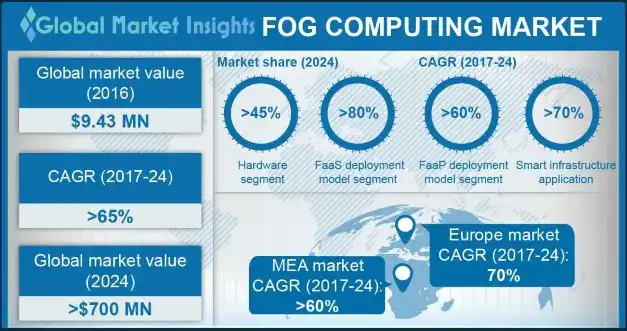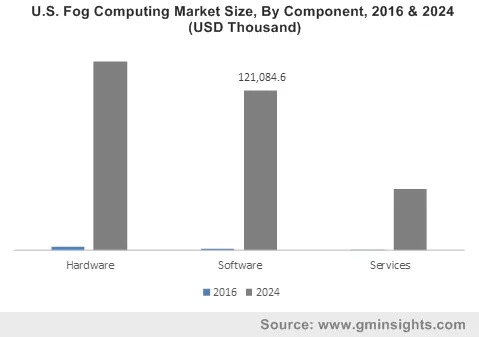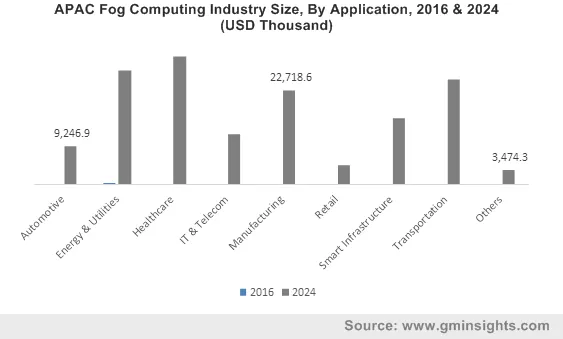


Fog Computing Market
Get a free sample of this report
Your inquiry has been received. Our team will reach out to you with the required details via email. To ensure that you don't miss their response, kindly remember to check your spam folder as well!
Form submitted successfully!
Error submitting form. Please try again.

Request Sectional Data
Your inquiry has been received. Our team will reach out to you with the required details via email. To ensure that you don't miss their response, kindly remember to check your spam folder as well!
Form submitted successfully!
Error submitting form. Please try again.
Fog Computing Market size surpassed USD 9 million in 2016 and is expected to witness a massive growth of around 65% from 2017 to 2024.

The fog computing market growth is attributed to the rising IoT implementation in various industry verticals including smart infrastructure, automotive, healthcare, retail, and energy. The data generated from connected devices can be utilized in various ways, especially in extracting insights. However, the volume of data can overwhelm the capabilities of storage and computing applications. The fog computing model is widely used as it integrates cloud resources close to the edge device, reducing the time required to transmit data and overcome latency issues. The rising adoption of cloud computing platforms will also propel market growth as fog enhances the capabilities of such platforms by connecting a wide range of devices to the cloud. It overcomes the limitations of cloud computing such as latency & frequency issues, scalability limitations, and resource management.
| Report Attribute | Details |
|---|---|
| Base Year: | 2016 |
| Fog Computing Market size in 2016: | 9 Million (USD) |
| Forecast Period: | 2017 - 2024 |
| Forecast Period 2023 - 2032 CAGR: | 65 |
| 2023 Value Projection: | 700 Million (USD) |
| Historical Data for: | 2013 - 2016 |
| No of Pages: | 350 |
| Tables, Charts & Figures: | 821 |
| Segments Covered: | Component, Deployment Model, Application and Region |
| Growth Drivers: |
|
| Pitfalls Challenges: |
|
As smartphones are becoming ubiquitous, there has been explosive growth in mobile data traffic. To accommodate the surge in data traffic, the demand for fog computing will increase to provide mobile users the demanded services through low-latency connections.

The services market will grow at a CAGR of over 70% owing to the increasing adoption of cloud computing platforms among industries. Since organizations are shifting their entire infrastructure into the cloud, professional services help to minimize the overall cost of operations in organizations by eliminating the maintenance expenses of physical IT infrastructures and staff hiring costs. The managed services market will observe the fastest growth rate due to the growing popularity of outsourcing strategic management functions and responsibilities to third-party service providers.
The Fog as a Product (FaaP) deployment model is anticipated to grow at a CAGR of over 60% from 2017 to 2024. The growth of the market is attributed to robust functionality and superior data security provided by the FaaP product. However, high capital requirements and increasing needs to reduce operating costs are some of the major constraints in the fog computing market demand.

The automotive application segment is expected to exhibit a growth rate of over 65% due to the rising usage of fog computing solutions to support the development of connected cars. The connected cars display a rich set of interactions and connectivity from cars to cars, cars to access points (such as smart traffic signals, roadside units), and access points to access points. Fog computing demonstrated various features that make it an ideal platform for delivering a wide range of Smart Connected Vehicles (SCV) services in traffic support, safety, mobility & location awareness, heterogeneity, real-time interactions, and low latency.
The MEA fog computing market is predicted to grow at a CAGR of over 60% due to the proliferation of IoT platforms and the heavy adoption of cloud computing among enterprises to improve their efficiency. The increasing digitalization in the region is also estimated to drive market growth. The government initiatives are also playing a vital role in the growth of industries. Several Middle East countries have adopted different strategies, visions, and initiatives to increase the adoption of technology and digitalization in the region. For instance, the UAE’s National Innovation Strategy focuses on the development of smart cities and smart buildings. fog computing fog computing software is also estimated to accelerate the market growth.
Companies present in the market are adopting strategies such as new product developments and strategic partnerships to strengthen their solutions’ capabilities. For instance, in July 2016, Yokogawa Electric Corporation invested in FogHorn Systems to accelerate the development of fog computing technology to further expand its solutions portfolio. In November 2017, NEC Laboratories Europe developed a cloud computing framework, FogFlow for edge based IoT services. The framework helped to extend the capabilities of FIWARE context information management to support AI-enabled information processing for IoT devices.
Some of the major companies of the fog computing market are:
Fog computing is gaining popularity as it supports cloud computing to handle massive volumes of data generated from IoT devices. The technology brings several benefits including enhanced performance, network bandwidth savings, and improved security. The technology is evolving at a faster pace as it brings benefits of cloud computing to the network devices for faster data analytics. With the rapid usage of IoT in various industry verticals, the demand for fog computing solutions will rise to analyze the time-sensitive data at network edges. These solutions will improve the performance of IoT applications that demand real-time and predictable latency.
Fog computing manufacturers are implementing umpteen strategies and tactics such as acquisitions, collaborations, and mergers, and product launches to bolster their geographical presence.
MEA market is observing considerable demand due to penetration of IoT platforms along with the adoption of cloud computing amongst various companies.
The market size of fog computing was surpassed USD 9 million in 2016.
The industry share of fog computing is expected to witness a massive growth of around 65% to 2024.
Fog as a Product deployment model will register considerable demand in the near future attributing to robust functionality and exceptional data security it provides.
The fog computing models potentially integrate cloud resources near to the edge device, cutting down the time required to transfer data and overcome latency issues, and allowing it to gain widespread prominence globally.